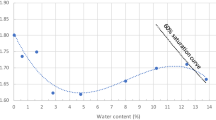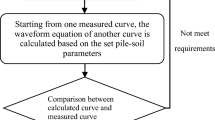Abstract
To relieve the increasing traffic load, many early built highways need to be widened or reconstructed. The rapid performance detection to existing subgrades is important to their reasonable evaluation and maximized utilization. Based on five kinds of soils taken from an existing highway in southern China, three commonly detecting methods were used to determine their moisture contents, compaction degrees and resilient moduli. The results showed that the measured moisture contents were greater than the design value, and the compaction degrees decreased sharply compared to the original ones. The moisture and heat exchange produced a decrease in the resilient modulus of plate loading test (PLT) from the standard 60 MPa down to 40 MPa. Afterwards, the portable falling weight deflectometer (PFWD) and dynamic cone penetrometer (DCP) were used to evaluate the subgrade performances. The measured PFWD moduli and the DCP penetration rates were correlated with the resilient moduli of PLT, deflections of the Beckman beam test, compaction degrees and moisture contents. The correlation analysis indicates that both of two methods are suitable in rapid detecting subgrade performances, but PFWD method is more recommended for it has higher accuracy and efficiency.
摘要
为了缓解日益增长的交通压力,许多早期修建的道路都需进行加宽。对既有路基的快速检测有 助于准确评估其性能状态,实现其最大程度的利用。在华南地区的某一老路基试验段选取了五种土, 采用3 种常规检测方法,分别测定其含水量、压实度和弹性模量。结果表明,经过多年运营后,路基 实测含水率大于设计值,实测压实度较设计值显著降低。路基和大气的水热交换使得其弹性模量从标 准的60 MPa 下降至40 MPa。随后,采用便携式落锤式弯沉仪(PFWD)和动力锥贯入仪(DCP)对路基进 行性能检测。将PFWD 模量和DCP 贯入度与回弹模量、贝克曼梁弯沉、压实度和含水量进行了关联 分析,证实这两种方法都适用于路基性能的快速检测,但PFWD 方法具有更高的精度和效率。
Similar content being viewed by others
References
LIU Yue, DING Yuan-yuan, WANG Na. Present construction situation and development trend of highway reconstruction and expansion projects [J]. Engineering Construction, 2015, 47(5): 53–57. DOI: https://doi.org/10.13402/j.gcjs.2015.05.012. (in Chinese)
ZHANG Jun-hui, PENG Jun-hui, ZHENG Jian-long, YAO Yong-sheng. Characterisation of stress and moisture-dependent resilient behaviour for compacted clays in South China [J]. Road Materials and Pavement Design, 2020, 21(1): 262–275. DOI: https://doi.org/10.1080/14680629.2018.1481138.
PENG Jun-hui, ZHANG Jun-hui, LI Jue, YAO Yong-sheng, ZHANG An-shun. Modeling humidity and stress-dependent subgrade soils in flexible pavements [J]. Computers and Geotechnics, 2020, 120: 103413. DOI: https://doi.org/10.1016/j.compgeo.2019.103413.
PARIVALLAL S, RAVISANKAR K, NAGAMANI K, KESAVAN K. Core-drilling technique for in-situ stress evaluation in concrete structures [J]. Experimental Techniques, 2011, 35(4): 29–34. DOI: https://doi.org/10.1111/j.1747-1567.2010.00622.x.
ZHENG Ming, YANG Jian-ming, LI Zi-long, ZHOU Ming-hui. Plate load test applied to detect bearing capacity of the miscellaneous fill subgrade reinforced by the dynamic compaction [J]. Advanced Materials Research, 2014, 1065–1069(2015): 778–782. DOI: https://doi.org/10.4028/www.scientific.net/AMR.1065-1069.778.
ZENG Ling, XIAO Liu-yi, ZHANG Jun-hui, FU Hong-yuan. The role of nanotechnology in subgrade and pavement engineering: A review [J]. Journal of Nanoscience and Nanotechnology, 2020, 20: 4607–4618. DOI: https://doi.org/10.1166/jnn.2020.18491.
ZHANG Jun-hui, GU Fan, ZHANG Yu-qing. Use of building-related construction and demolition wastes in highway embankment: Laboratory and field evaluations [J]. Journal of Cleaner Production, 2019, 230: 1051–1060. DOI: https://doi.org/10.1016/j.jclepro.2019.05.182.
ZHANG Jun-hui, PENG Jun-hui, ZENG Ling, LI Jue, LI Feng. Rapid estimation of resilient modulus of subgrade soils using performance-related soil properties [J]. International Journal of Pavement Engineering, 2019. DOI: https://doi.org/10.1080/10298436.2019.1643022.
MARECOS V, FONTUL S, ANTUNES M D L. Evaluation of a highway pavement using non-destructive tests: Falling weight deflectometer and ground penetrating radar [J]. Construction & Building Materials, 2017, 154: 1164–1172. DOI: https://doi.org/10.1016/j.conbuildmat.2017.07.034.
LIN D F, LIAU C C, LIN J D. Factors affecting portable falling weight deflectometer measurements [J]. Journal Geotechnical and Geoenvironmental Engineering, 2006, 132(6): 804–808. DOI: https://doi.org/10.1061/(ASCE)1090-0241(2006)132:6(804).
KUMAR R, ADIGOPULA V K, GUZZARLAPUDI S D. Stiffness-based quality control evaluation of modified subgrade soil using lightweight deflectometer [J]. Journal of Materials in Civil Engineering, 2017, 29(9): 1–17. DOI: https://doi.org/10.1061/(ASCE)MT.1943-5533.0001958.
MICHAEL A, MOONEY P K M. Analysis of lightweight deflectometer test based on in situ stress and strain response [J]. Journal of Geotechnical and Geoenvironmental Engineering, 2009, 135(2): 199–208. DOI: https://doi.org/10.1061/(ASCE)1090-0241(2009)135:2(199).
GRASMICK J G, MOONEY M A, SURDAHL R W, VOTH M, SENSENEY C. Capturing a layer response during the curing of stabilized earthwork using a multiple sensor lightweight deflectometer [J]. Journal of Materials in Civil Engineering, 2015, 27(6): 04014183. DOI: https://doi.org/10.1061/(ASCE)MT.1943-5533.0001137.
KIM N, IM S B. A comparative study on measured vs predicted pavement responses from falling weight deflectometer measurements [J]. KSCE Journal of Civil Engineering, 2005, 9(2): 91–96. DOI: https://doi.org/10.1007/bf02829063.
KAVUSSI A, RAFIEI K, SHAHABODDIN Y. Evaluation of PFWD as potential quality control tool of pavement layers [J]. Journal of Civil Engineering and Management, 2010, 16(1): 123–129. DOI: https://doi.org/10.3846/jcem.2010.11.
KAVUSSI A, ABBASGHORBANI M, MOGHADASNEJAD F, BAMDAD-ZIKSARI A. A new method to determine maintenance and repair activities at network-level pavement management using falling weight deflectometer [J]. Journal of Civil Engineering and Management, 2017, 23(3): 338–346. DOI: https://doi.org/10.3846/13923730.2015.1073173.
MARRADI A, PINORI U, BETTI G. Subgrade and foundation dynamic performance evaluation by means of lightweight deflectometer tests [J]. Journal of the Transportation Research Board, 2018, 2457(1): 51–57. DOI: https://doi.org/10.3141/2457-06.
ZHANG Jun-hui, DING Le, LI Feng, PENG Jun-hui. Recycled aggregates from construction and demolition wastes as alternative filling materials for highway subgrades in China [J]. Journal of Cleaner Production, 2020, 255: 120223. DOI: https://doi.org/10.1016/j.jclepro.2020.120223.
ASHRAF R, GEORGE K P. Falling weight deflectometer for estimating subgrade elastic moduli [J]. Journal of Transportation Engineering, 2003, 129(1): 100–107. DOI: https://doi.org/10.1061/(asce)0733-947x(2003)129:1(100).
KHALID A, MURAD A F, EKREM S. Laboratory evaluation of the geogauge and light falling weight deflectometer as construction control tools [J]. Journal of Materials in Civil Engineering, 2005, 17(5): 560–569. DOI: https://doi.org/10.1061/(ASCE)0899-1561(2005)17:5(560).
SCALA A J. Simple methods of flexible pavement design using cone penetrometers [J]. New Zealand Engineering, 1956, 11(2): 33–34. https://search.informit.com.au/documentSummary;dn=696574404729714;res=IELENG.
SHABAN A M, COSENTINO P J. Preliminary investigation of predicting permanent deformations of unbound granular materials using miniaturized pressuremeter cyclic data [J]. Journal of Testing & Evaluation, 2018, 46(5): 20160571. DOI: https://doi.org/10.1520/JTE20160571.
YANG Bo, ZHANG Rui, ZHA Xu-dong, LIU Chuang, PAN Qing-xue. Improved testing method of dynamic cone penetrometer in laboratory for evaluating compaction properties of soil subgrade [J]. Road Materials and Pavement Design, 2015, 17(2): 487–498. DOI: https://doi.org/10.1080/14680629.2015.1091375.
GEORGE V, RAO N C, SHIVASHANKAR R. PFWD, DCP and CBR correlations for evaluation of lateritic subgrades [J]. International Journal of Pavement Engineering, 2009, 10(3): 189–199. DOI: https://doi.org/10.1080/10298430802342765.
MOHAMMADI S D, NIKOUDEL M R, RAHIMI H, KHAMEHCHIYAN M. Application of the dynamic cone penetrometer (DCP) for determination of the engineering parameters of sandy soils [J]. Engineering Geology, 2008, 101(3, 4): 195–203. DOI: https://doi.org/10.1016/j.enggeo.2008.05.006.
BYUN Y H, KIM J H, LEE J S. Cone penetrometer with a helical-type outer screw rod for evaluation of the subgrade condition [J]. Journal of Transportation Engineering, 2013, 139(2): 115–122. DOI: https://doi.org/10.1061/(asce)te.1943-5436.0000504.
SUDNITSYN I I. Effect of the size of elementary soil particles on the soil moisture characteristic curve [J]. Eurasian Soil Science, 2015, 48(7): 735–741. DOI: https://doi.org/10.1134/S1064229315050117.
AL-BADRAN Y, SCHANZ T. Modelling the compaction curve of fine-grained soils [J]. Soils and Foundations, 2014, 54(3): 426–438. DOI: https://doi.org/10.1016/j.sandf.2014.04.011.
ZHANG Jun-hui, PENG Jun-hui, LIU Wei-zheng, LU Wei-hua. Predicting resilient modulus of fine-grained subgrade soils considering relative compaction and matric suction [J]. Road Materials and Pavement Design, 2019. DOI: https://doi.org/10.1080/14680629.2019.1651756.
NG C W W, ZHOU C, YUAN Q, XU J. Resilient modulus of unsaturated subgrade soil: Experimental and theoretical investigations [J]. Canadian Geotechnical Journal, 2013, 50(2): 223–232. DOI: https://doi.org/10.1139/cgj-2012-0052.
RAFIEI K, KAVUSSI A, YASROBI S. Construction quality control of unbound layers based on stiffness modulus criteria [J]. Journal of Civil Engineering and Management, 2012, 18(1): 5–13. DOI: https://doi.org/10.3846/13923730.2011.619328.
VARGHESE G, ANIL K. Studies on modulus of resilience using cyclic tri-axial test and correlations to PFWD, DCP and CBR [J]. International Journal of Pavement Engineering, 2016, 19(11): 976–985. DOI: https://doi.org/10.1080/10298436.2016.1230428
GAO Y, HE B, XIAO M. Study on properties and mechanisms of luminescent cement-based pavement materials with super-hydrophobic function [J]. Construction & Building Materials, 2018, 165: 548–559. DOI: https://doi.org/10.1016/j.conbuildmat.2017.12.231.
Author information
Authors and Affiliations
Corresponding author
Additional information
Foundation item: Project(2017YFC0805307) supported by the National Key Research and Development Program of China; Projects(51878078, 51927814, 51911530215) supported by the National Natural Science Foundation of China; Project(2018-025) supported by the Training Program for High-level Technical Personnel in Transportation Industry, China; Project (2018JJ1026) supported by the Excellent Youth Foundation of Natural Science Foundation of Hunan Province, China; Project(17A008) supported by the Key Project of Education Department of Hunan Province, China; Projects(kfj150103, kfj170104) supported by the Open Research Fund of State Engineering Laboratory of Highway Maintenance Technology, Changsha University of Science & Technology, China; Project(CX20190644) supported by the Postgraduate Scientific Research Innovation Project of Hunan Province, China
Rights and permissions
About this article
Cite this article
Zhang, Jh., Ding, L., Zheng, Jl. et al. Deterioration mechanism and rapid detection of performances of an existing subgrade in southern China. J. Cent. South Univ. 27, 2134–2147 (2020). https://doi.org/10.1007/s11771-020-4436-5
Received:
Accepted:
Published:
Issue Date:
DOI: https://doi.org/10.1007/s11771-020-4436-5
Key words
- humid and hot areas
- existing subgrade
- deterioration mechanism
- rapid detection
- portable falling weight deflectometer
- dynamic cone penetrometer




